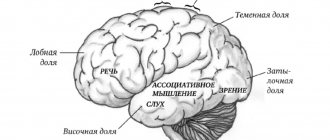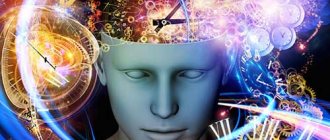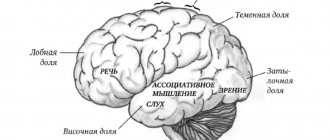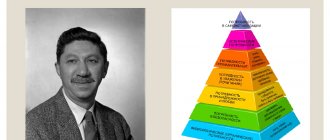The article describes in accessible language the basic laws and stages of the perception process that everyone needs to know.
We perceive the world through our sensations. When any objects impact our sense organs, temporary nerve connections are formed in the cerebral cortex, conditionally reflex processes; stimuli are analyzed and synthesized. Perception is a mental process of searching for signs on the basis of which an image can be formed and comprehended. At the same time, our sensations are selected, systematized and interpreted in some way.
As a result of perception, we receive an image. One of the analyzers plays a leading role in this process and determines important features, and on their basis – the properties of the perceived object. Based on the analyzers that take part in the process of perception, visual, tactile, auditory, muscular and other perceptions are distinguished.
In humans, as a rule, the leading sense organ is vision, and therefore the properties of perception were studied primarily on this basis. Investigating what and how influences the formation of visual images, representatives of Gestalt psychology (early 19th century, Germany) derived the laws of visual perception (according to M. Wertheimer):
- If the figures are similar, that is, if they are united by some common characteristics (for example, shape), then, based on the similarity, our perception combines them into groups.
- If the figures are located close to each other, our perception tries to unite them.
- If the figures have any similar changes, our perception also tries to unite and group them.
- If the figures are in a confined space, they are perceived better and easier.
- If there are several figures, they try to group them in such a way as to unite all without exception, so that not a single free-standing figure remains.
Science cannot yet explain the mechanism of the brain that forces us to adhere to these laws of visual perception. Therefore, the identified patterns are so far simply perceived as phenomenological.
The following observations should also be included in the laws of perception:
- Whatever we perceive, the brain structures incoming signals, perceiving them as figure and ground. What is clear to us, clearly perceived, is the figure, and its surroundings are the background. When switching attention, the background and figure can change places (as in the picture of the Rubin vase). This selection of a “figure” from the “background” can concern not only vision, but also, for example, hearing (we “snatch” words of interest from a stream of noise: for example, our name), smell, etc.
- No matter what we observe, the brain tries to “complete” the missing fragments into a whole figure, to show the integrity of the image. This applies not only to the image, melody, elements of phrases or words, this is also the law of human perception by man: we infer what we do not know based on what we see and hear.
- But perception is influenced by our expectations, guesses, assumptions: what is presented to us, we perceive based on its environment, likening it to something similar. For example, as a manifestation of this law, when perceiving a person as a person, we attribute to people the traits that we expect to see in them.
In psychology, the following laws of perception are also distinguished:
- Perception is associated with the work of muscles, with movements containing information about the objects that are perceived.
- Already formed images are relatively stable, especially if associated with thinking.
- A necessary condition for correct perception is the constant supply of new information that clarifies and corrects the emerging image.
- In the process of development of perception, the formation of images depends on the experience gained, sensations, and when perception has already been formed, the nature of the images is partially determined by the internal processes occurring in the body.
Basic provisions
A white object, even in the dark, will be white. Because the person knows him that way.
The departing car, although it will shrink, will remain large in perception. Even if there is already a grain of sand in sight.
Without constancy of perception it would be difficult. Objects and people would seem something new to us. The person could simply turn in the other direction and would no longer be recognizable.
Objectivity of perception
This is the ability to perceive the world not as a set of individual elements, but as a whole.
It develops throughout life. I. Sechenov believes that its development occurs in the process of the child’s contact with objects.
Objectivity develops through motor skills:
- movement of hands and fingers when feeling objects;
- movement of the eyes when highlighting the outline of an object and “feeling” it from a distance;
- turning the head;
- other movements.
Perceptual process
Awareness of the world through the work of the senses.
Depending on which organ plays a role, they are divided into visual, auditory, olfactory and others.
The formation of a perceptual image consists of the following phases:
- Detection. The stage at which a person distinguishes an object from the background, but cannot yet reason about its characteristics.
- Discrimination. The stage at which a person can separately perceive nearby objects.
- Identification. The stage at which a person fixes properties and assigns them to a certain class.
Definition
The word “mediate” is a verb that denotes performing an action not directly, but through an intermediary, obtaining a result by transferring a function from one object to another. It can be anything: an object, an action, knowledge, a person, etc. The object receives a result without performing a direct action for this - indirectly.
The opposite in meaning concept is directly. That is, you can find out what time it is (directly) by looking at your watch or (indirectly) by asking someone.
We receive information about the environment through the skin (temperature, humidity, material characteristics, etc.), eyes (light, color, movement, etc.), ears (loudness, vibrations, etc.). But this perception itself is considered direct because it gives us answers directly. He put his hand under the stream of water and determined whether it was wet or cold, wiped it with a towel - it was warm and dry, and the towel itself was soft and fluffy. The power of our vision is not enough to see distant stars and planets - we take a telescope as an intermediary and study them indirectly.
Perceptual side of communication
The process in which people, through communication, perceive each other and establish contact.
A minimum of two people are involved. Ideas about the intentions, feelings, thoughts of the interlocutor and oneself are created.
People become aware of themselves and others through the following mechanisms:
- knowledge and understanding of each other;
- self-awareness in the process of communication;
- in communication, predicting the future behavior of a partner.
The most common perceptual errors in psychology
From psychological practice, several common situations can be identified that cause difficulties in perception. Here are the most common perception errors:
The illusion of control. If a person is interested in the outcome of a particular situation, he tends to overestimate his influence on it. This phenomenon was discovered by the American psychologist Langer, who studied the behavior of people playing the lottery. One group bought tickets themselves, and the second received them as a gift. The former categorically refused the offer to exchange tickets, as they believed that their personal choice affected the likelihood of winning. Zero risk preference. If a person is offered to reduce a minor risk to zero or significantly reduce a significant one, he is most likely to choose the first option. Although, it is much wiser to give preference to the second. Selective perception. For example, you have developed an opinion on a specific issue. You are looking for information and are becoming more and more convinced that you are right.
But the catch is that you pay attention only to the information that confirms that you are right, and leave the rest without attention. The illusion of transparency
This error of social perception occurs when a person finds himself in a situation in which it is necessary to lie. At the moment, it seems to him that everyone sees right through him, that everyone sees his insincerity. Attribution error. It consists in the fact that a person explains his own mistakes by objective circumstances, and the mistakes of others by their personal qualities. This approach impedes the individual's ability to take responsibility for his actions. The effect of moral trust. If a person has a strong positive reputation in society, others begin to think that he has neither vices nor bad intentions, which is often not true. Cascade of available information. If some information appears frequently in sources that reach a large audience, it is considered true. The older generation is influenced by television and the press, and the younger generation is influenced by social networks. Stockholm buyer syndrome. This is the name of the error of perception when a person justifies an expensive purchase, attributing all sorts of advantages to it and turning a blind eye to the shortcomings. Purchases made unnecessarily are justified in the same way. Belief in a just world. Since people are afraid to realize the injustice and chaos of the world around them, they tend to find logic even in the most terrible and absurd situations. Distorted perception of distortions. If you don’t find any vices or shortcomings in yourself, then you definitely have them. But you perceive them in a positive way, that is, distorted.
The role of attitude in perceptual processes
Attitude affects people. When a person unconsciously reacts in a habitual way to information or people without analyzing it.
Settings are divided into 3 dimensions:
- Cognitive dimension - certain opinions, thoughts, beliefs about something or someone.
- The affective dimension is the presence of negative or positive emotions towards a person or information.
- Behavioral dimension – preparedness for behavioral reactions that correspond to a person’s beliefs.
Settings are formed:
- under the influence of others. These could be parents, the yellow press, acquaintances and friends;
- based on past experience in repeated situations.
Indirect Thinking
Life often presents us with tasks that cannot be solved directly, directly. Knowing how to find the answer (perform a certain algorithm of actions) in similar, but simpler situations, we can mediate this knowledge for situations beyond our direct control (as with the planets).
When we apply any law, tested and reliably proven on elementary objects, to complex, abstract objects and obtain new knowledge, new results, our indirect thinking works.
We use it when:
- working with an object directly is impossible due to the underdevelopment or lack of necessary reflexes, sensory organs, etc. (ultrasound, radiation);
- direct knowledge is possible, but not in real time (history, archaeology);
- indirect cognition, the study of objects is more rational (measurement of mass, volume, height of large objects).
The role of motivation in perceptual processes
Motivation
A reason that encourages action.
It can be guided by primitive factors. For example, hunger, cold. Or psychological needs for love, respect, recognition. Motivation plays a role in the desire for self-actualization.
For example, when feeling hungry, a person may read “lunch” instead of the word “shoes.” Carried away by ambition is a misheard phrase. An old example can be given: a person spends a long time in the desert and is tormented by thirst. After some time, he sees in the distance an oasis with clear and cool water.
Stages of the perception process
If perception is considered as a mental process in which there is a search for signs that form an image and contribute to making decisions on this basis, the following stages can be distinguished in it:
- Stimuli are identified from the flow of information, and on their basis a decision is made about their relationship to any one specific object.
- The same or similar complex of sensations are extracted from the memory archive. They are compared with the current characteristics, on the basis of which a judgment is formed about what kind of object is in front of us.
- The perceived object belongs to a certain category, then the search continues for signs that help determine whether the decision was made correctly or incorrectly.
- A final conclusion is made about what kind of object is in front of us, and it is endowed with properties inherent in objects of the same class as it.
Theories
There are several scientifically based theories of perception that have their own valid arguments:
- Associative , its prominent representative was G. Helmholtz - according to this theory, the image of objects and phenomena is formed on the basis of associative sensations.
- Gestalt theory - its adherents, on the contrary, believed that we perceive each object as a separate whole, without connection with past experience and associations.
- Gibson's theory - its adherents were confident that perception cannot be objective, it depends on the degree of human activity; movement, in their opinion, is the basis of perception.
- According to Hebb's theory , perception is not an innate trait and has no innate elements at all; a person learns to understand the world gradually, first learning the details, and then the whole.
- The theory of perception by J. Piaget , who closely linked perception with the development of intelligence, is based almost on this
Effects and phenomena
A separate chapter of perception in psychology is the perception of a person by a person. It has a number of effects and phenomena, which are clearly shown in the table.
| Effect name | Causes | What is expressed in |
| The effect of primacy and novelty | Meeting with a stranger | The first impressions received are taken as a basis |
| Halo effect | There is already certain information about the person | The impressions received are projected onto previously known ones through the aura of rumors, information, etc. |
| Attractiveness effect | A person's appearance | We perceive an outwardly attractive person better |
| Superiority effect | Comparison of behavior, appearance, etc. | Feeling our supposed superiority over our interlocutor in some respects, we may underestimate him; the process may also be reversed. |
| Good attitude effect | Sympathy for a person | Overestimation of the interlocutor |
| Projection effect | Increased self-esteem | A pleasant person is assigned his own merits, and an unpleasant person is assigned his own disadvantages. |
Constancy of form
Distortions in the perception of the shape of objects can be encountered when the orientation of objects or the subject itself changes. This type is one of the important properties of the visual system, since correct recognition of the shape of objects is a necessary condition for adequate human interaction with the outside world. One of the first to identify the role of observer knowledge and signs of distance in the constancy of form was Robert Thouless.
In 1931, a psychologist conducted an experiment, the essence of which was as follows: he asked subjects to evaluate and draw or select from a certain set of squares or circles that would be similar in shape to the proposed objects lying on a horizontal surface at different distances from the observer. As a result of the experiment, the subjects chose a stimulus form that did not coincide with either the projection form or its real form, but lay between them.
The illusion of reality
The illusion of perception occurs when reality is reflected distortedly, while the effect is sustainable. Illusions can occur in many people under the influence of physical, physiological and psychological reasons.
The breaking of a spoon in a glass of tea is classified as a physical illusion, and the splitting of the image when pressing sideways on the eyeball is considered a physiological illusion. A psychological illusion occurs when identical lines are overestimated up or down when their lengths are objectively equal.
Another example considers overvaluing the top parts of the figure. When dividing a vertical line in half, a person often makes the mistake of setting the middle much higher than the real one.
Basic properties of perception with examples
The mental process under consideration has the following properties:
- Integrity is a characteristic of the final image that arises as a result of a combination of sensations. The final image is always complete. For example, a fly is perceived by a frog as an object of hunting only when the fly moves. If the fly is motionless, the frog does not try to catch it, since it does not perceive it as an insect.
- Constancy - once acquired characteristics of a particular object, a person tends to correlate it with this particular object for a long time, accurately forming the final image. Minor changes in the characteristics of an item do not lead to difficulties with its classification. So, for example, a young man dates a tall girl who has blue eyes and blond hair. One day his girlfriend dyed her hair brunette. But he still perceives her as his partner; she has not become a stranger to him.
- Subjectness - the ability to combine an object with a generic group according to key characteristics. For example, green, round, sweet - this is an apple. Green, long, with paws and a tail - this is a crocodile. The process of classifying items into generic groups may take some time. Sometimes, for a correct correlation, a person needs to come up and take a closer look at the object or pick it up.
Objectivity of perception
- Structurality is reflected in the complexity of the perception process, which cannot be reduced simply to the sum of sensations from different senses. Replacing one of the key characteristics leads to the formation of a completely new image. So, for example, something large, iron and capable of floating is a ship. However, a large, iron one, capable of moving along railroad tracks is a train, not a ship.
- Selectivity – selection of 1 object from the background. The scope of perception is limited. A child cannot play with many toys at the same time. First of all, he will take the brightest or largest toy. This turns on selectivity: the baby chooses the most eye-catching object by color or size. Having chosen his favorite toy from a variety, the child loses interest in the others for a while; only the best one is in his field of perception.
- Apperception is the dependence of image formation on the individual characteristics of a person’s analytical systems and his life experience. The same object can be perceived differently by different people. So, for example, the Bible for believers is one of the main books of life, which sets out the rules of life and the foundations of society, but for an atheist it seems to be just a book that is no different from any other work of art.
- Perception activity is a person’s ability to be aware of the surrounding reality and accumulate experience in using objects. For example, initially the baby does not know what function the spoon performs. He can knock on the wall with it, look at it like in a mirror, dig sand with it. One day his mother shows him that he can eat with a spoon. Having learned this, the baby understands that a spoon is a cutlery, and not a hammer, a mirror or a spatula.
Classification of properties
Perception is the knowledge of a complex image of an object. A person forms his own model of the objective external world. At the first contact with an object, the human brain receives knowledge about it and forms an image of sensation, then on this basis an image of perception is created.
The leading properties of perception (perception) include:
- Integrity.
- Meaningfulness.
- Generality.
- Constancy.
- Objectivity.
- Selectivity.
Integrity refers to the knowledge of information or an object as a whole, despite the absence of essential details. An object is reflected in the totality of all its properties. Let's say a house without a roof, windows, pipes will still be recognized as a house, only unfinished or destroyed.
Meaningfulness is an understanding of what exactly is perceived and its relationship with knowledge and past experience. Even in unfamiliar objects, similarities with familiar objects are detected. A person who is far from technology will create a connection between the structure he sees with light bulbs and wires, assuming that it is a scientific device.
Generalization is a concept when individual objects are classified as homogeneous according to certain characteristics.
Constancy of perception is the constancy of the perceived shape, size and color of an object, regardless of significant changes in conditions. For example, a bird in flight, in a cage, or in a tree is perceived the same way - as a bird. The same applies to color perception. Red will always remain so in any light. Thanks to constancy, a person recognizes objects under any conditions.
Objectivity is a meaningful, integral image when not only the color, shape or size is perceived, but the functions, properties, and purpose of the object. For example, a spoon has not only color and shape, but also a purpose - a cutlery. The meaning put into the image is important.
Selectivity - an object is distinguished from others based on personal experience. Based on the described characteristics, perception has properties that determine its productivity:
- Volume is the number of objects perceived simultaneously.
- Speed is the time spent on perceptual actions (detection, recognition, discrimination).
- Accuracy is the correspondence of the image to the characteristics and task assigned to the person.
- Completeness—level of compliance.
- Reliability is the duration of perception with the required accuracy, adequate acceptance of an object at a given time and condition.
By analyzing the indicators, one can judge a person’s perceptual abilities.
Modality
There are 4 sensory information perception systems (models - hence the name) that people use:
- the visual system involves the perception of color and shape, that is, what we see;
- the auditory system uses sounds, their volume, timbre, rhythm, frequency;
- the kinesthetic system perceives taste, smell, temperature;
- digital uses logical constructions.
Physiological basis
What is the psychophysiology of perception? The processes that occur during a person’s cognition of the surrounding world (this is an almost continuous process) can be recorded at the level of sensory organs , nerve fibers and the central nervous system; they are called the physiological basis of perception.
The mechanism of their action can be clearly explained as follows:
- stimuli at the nerve endings of the sense organs transmit the received information to the cerebral cortex;
- then it enters the projection zones of the brain, which are called sensory;
- a feeling of the information received and its comprehension is created.
Any “malfunction” of this chain can disrupt the integrity of perception.
For example, loss of vision , as a property of a sensory organ, limits the resulting image in terms of its color, volume, shape, etc., and a failure at the sensory level will lead to the fact that a person will perceive what he sees only as a set of light and color spots.
The nerve connections through which the process of perception works come in 2 directions:
- formed after the influence of one analyzer - for example, the noise of water in a river, which we do not yet see, affects only our hearing aid;
- inter-analyzer - figuratively speaking, they arise when we approach the river, here a whole complex of sensations comes into force, including associative ones.
Functions
During a person’s lifetime, perception performs several main functions :
- general orientation;
- assessment of the location of individual objects and phenomena;
- the cognitive function already includes the discovery of the essence of objects and phenomena, their interconnectedness;
- activity control;
- regulation of activities.
The main properties of perception include:
- objectivity - a person is aware of the object he sees as a separate body;
- integrity , - individual properties of objects necessarily (if we are talking about apperception) add up to a visual image;
- structure is not a mechanical sum of sensations, but their correlation over a period of time: when listening to music, we perceive not individual notes, but an evolving melody;
- constancy - thanks to this quality, a person perceives moving objects as constant in their form and properties;
- meaningfulness - at this stage the final formation of the image of an object and phenomenon and its place in the surrounding world occurs.









